Analysis of Gastronomy in Hopgood's and Co, New Zealand Hospitality
VerifiedAdded on 2023/01/17
|18
|4513
|96
Report
AI Summary
This report provides an executive summary and detailed analysis of Hopgood's and Co, a New Zealand-based hotel business located in Nelson, focusing on the application of gastronomy within the context of the hospitality industry. The study begins with an overview of the business, followed by a literature review that defines the concept of gastronomy, explores aspects of New Zealand cuisine and its wine industry, and examines the meal experience and menu development. The discussion section delves deeper into the application of gastronomy in the regional cuisine of New Zealand. The report then concludes with recommendations for the business. The report examines the restaurant's operations, cuisine, history, and food and beverage services offered, followed by an analysis of the concept of gastronomy, including its practical, food, theoretical, and technical components. It also addresses the aspects of New Zealand cuisine, including historical influences from Maori and European cultures and the impact of immigration. The report also includes an overview of the New Zealand wine industry, focusing on the Marlborough, Nelson, and Hawke's Bay regions. The report also analyzes the meal experience and the five key needs of customer satisfaction, which are physiological, economic, social, psychological, and convenience.
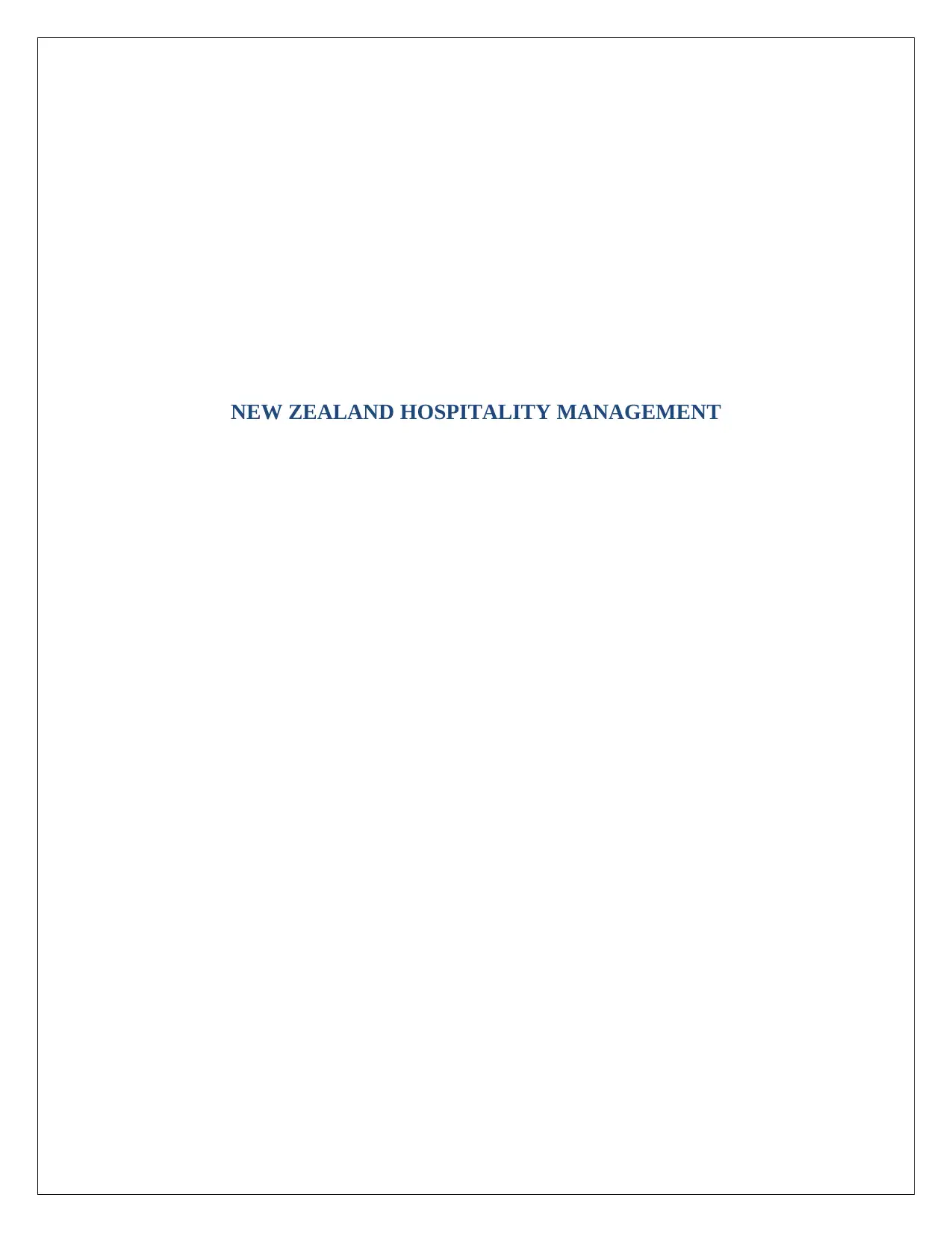
NEW ZEALAND HOSPITALITY MANAGEMENT
Paraphrase This Document
Need a fresh take? Get an instant paraphrase of this document with our AI Paraphraser
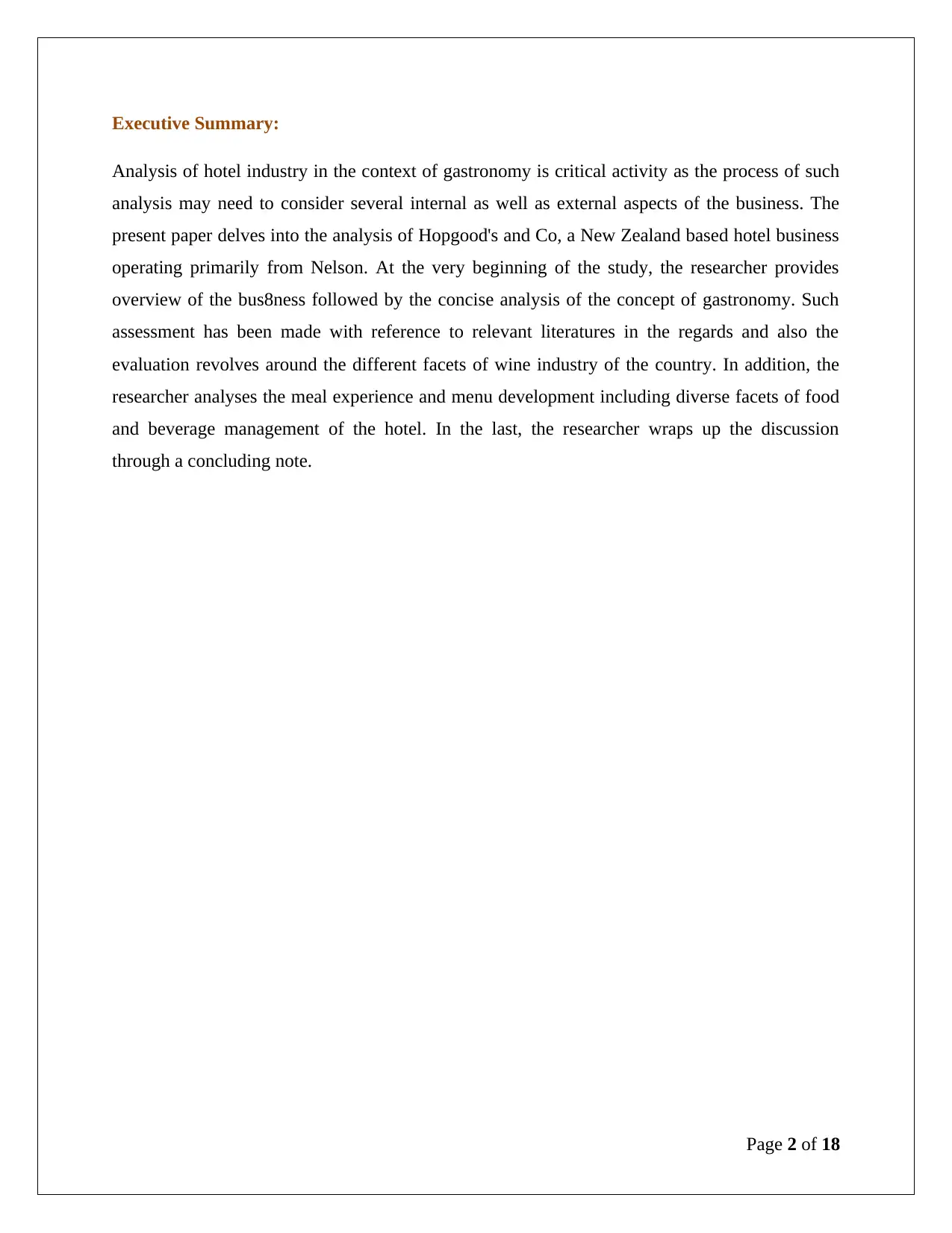
Executive Summary:
Analysis of hotel industry in the context of gastronomy is critical activity as the process of such
analysis may need to consider several internal as well as external aspects of the business. The
present paper delves into the analysis of Hopgood's and Co, a New Zealand based hotel business
operating primarily from Nelson. At the very beginning of the study, the researcher provides
overview of the bus8ness followed by the concise analysis of the concept of gastronomy. Such
assessment has been made with reference to relevant literatures in the regards and also the
evaluation revolves around the different facets of wine industry of the country. In addition, the
researcher analyses the meal experience and menu development including diverse facets of food
and beverage management of the hotel. In the last, the researcher wraps up the discussion
through a concluding note.
Page 2 of 18
Analysis of hotel industry in the context of gastronomy is critical activity as the process of such
analysis may need to consider several internal as well as external aspects of the business. The
present paper delves into the analysis of Hopgood's and Co, a New Zealand based hotel business
operating primarily from Nelson. At the very beginning of the study, the researcher provides
overview of the bus8ness followed by the concise analysis of the concept of gastronomy. Such
assessment has been made with reference to relevant literatures in the regards and also the
evaluation revolves around the different facets of wine industry of the country. In addition, the
researcher analyses the meal experience and menu development including diverse facets of food
and beverage management of the hotel. In the last, the researcher wraps up the discussion
through a concluding note.
Page 2 of 18
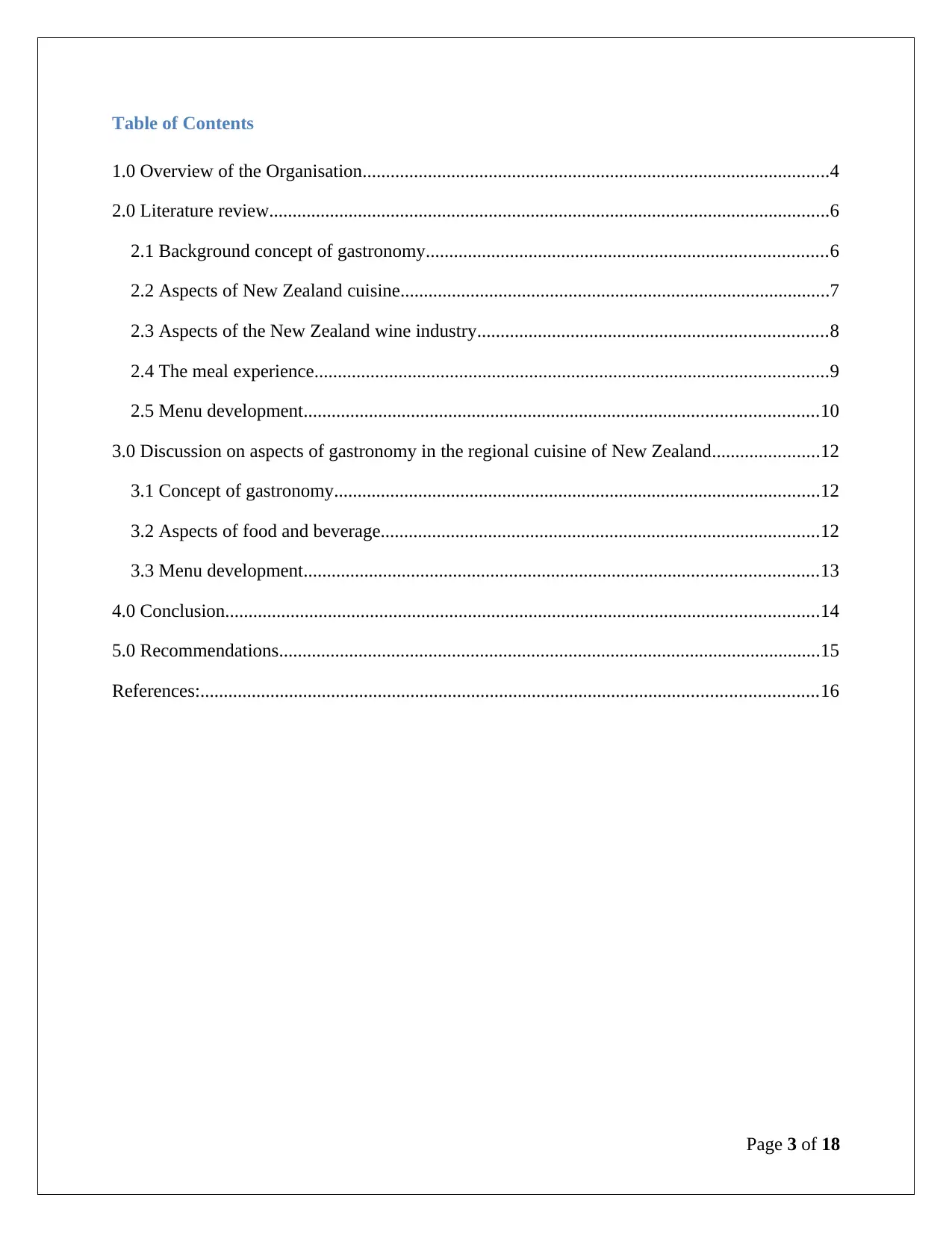
Table of Contents
1.0 Overview of the Organisation....................................................................................................4
2.0 Literature review........................................................................................................................6
2.1 Background concept of gastronomy......................................................................................6
2.2 Aspects of New Zealand cuisine............................................................................................7
2.3 Aspects of the New Zealand wine industry...........................................................................8
2.4 The meal experience..............................................................................................................9
2.5 Menu development..............................................................................................................10
3.0 Discussion on aspects of gastronomy in the regional cuisine of New Zealand.......................12
3.1 Concept of gastronomy........................................................................................................12
3.2 Aspects of food and beverage..............................................................................................12
3.3 Menu development..............................................................................................................13
4.0 Conclusion...............................................................................................................................14
5.0 Recommendations....................................................................................................................15
References:....................................................................................................................................16
Page 3 of 18
1.0 Overview of the Organisation....................................................................................................4
2.0 Literature review........................................................................................................................6
2.1 Background concept of gastronomy......................................................................................6
2.2 Aspects of New Zealand cuisine............................................................................................7
2.3 Aspects of the New Zealand wine industry...........................................................................8
2.4 The meal experience..............................................................................................................9
2.5 Menu development..............................................................................................................10
3.0 Discussion on aspects of gastronomy in the regional cuisine of New Zealand.......................12
3.1 Concept of gastronomy........................................................................................................12
3.2 Aspects of food and beverage..............................................................................................12
3.3 Menu development..............................................................................................................13
4.0 Conclusion...............................................................................................................................14
5.0 Recommendations....................................................................................................................15
References:....................................................................................................................................16
Page 3 of 18
⊘ This is a preview!⊘
Do you want full access?
Subscribe today to unlock all pages.

Trusted by 1+ million students worldwide
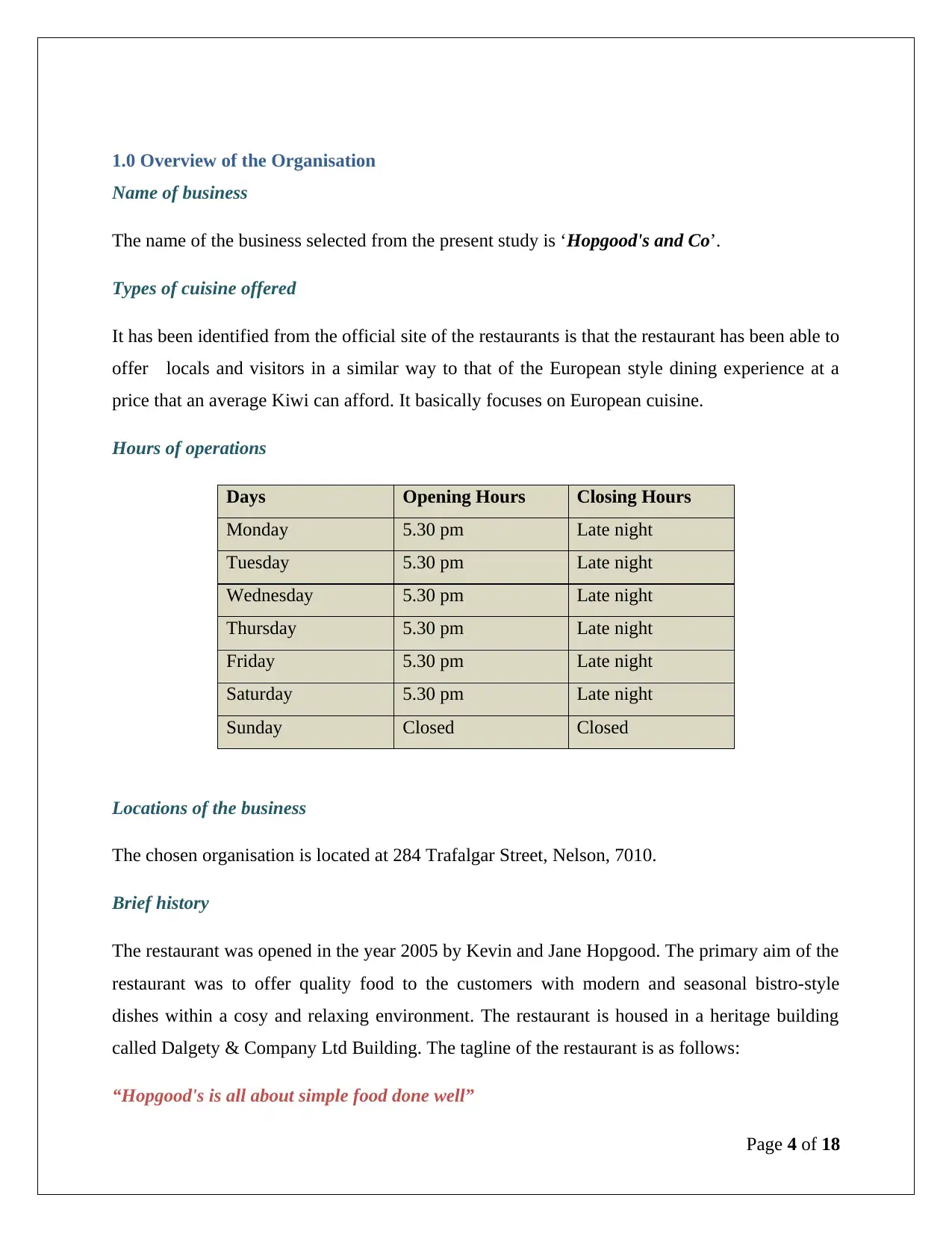
1.0 Overview of the Organisation
Name of business
The name of the business selected from the present study is ‘Hopgood's and Co’.
Types of cuisine offered
It has been identified from the official site of the restaurants is that the restaurant has been able to
offer locals and visitors in a similar way to that of the European style dining experience at a
price that an average Kiwi can afford. It basically focuses on European cuisine.
Hours of operations
Days Opening Hours Closing Hours
Monday 5.30 pm Late night
Tuesday 5.30 pm Late night
Wednesday 5.30 pm Late night
Thursday 5.30 pm Late night
Friday 5.30 pm Late night
Saturday 5.30 pm Late night
Sunday Closed Closed
Locations of the business
The chosen organisation is located at 284 Trafalgar Street, Nelson, 7010.
Brief history
The restaurant was opened in the year 2005 by Kevin and Jane Hopgood. The primary aim of the
restaurant was to offer quality food to the customers with modern and seasonal bistro-style
dishes within a cosy and relaxing environment. The restaurant is housed in a heritage building
called Dalgety & Company Ltd Building. The tagline of the restaurant is as follows:
“Hopgood's is all about simple food done well”
Page 4 of 18
Name of business
The name of the business selected from the present study is ‘Hopgood's and Co’.
Types of cuisine offered
It has been identified from the official site of the restaurants is that the restaurant has been able to
offer locals and visitors in a similar way to that of the European style dining experience at a
price that an average Kiwi can afford. It basically focuses on European cuisine.
Hours of operations
Days Opening Hours Closing Hours
Monday 5.30 pm Late night
Tuesday 5.30 pm Late night
Wednesday 5.30 pm Late night
Thursday 5.30 pm Late night
Friday 5.30 pm Late night
Saturday 5.30 pm Late night
Sunday Closed Closed
Locations of the business
The chosen organisation is located at 284 Trafalgar Street, Nelson, 7010.
Brief history
The restaurant was opened in the year 2005 by Kevin and Jane Hopgood. The primary aim of the
restaurant was to offer quality food to the customers with modern and seasonal bistro-style
dishes within a cosy and relaxing environment. The restaurant is housed in a heritage building
called Dalgety & Company Ltd Building. The tagline of the restaurant is as follows:
“Hopgood's is all about simple food done well”
Page 4 of 18
Paraphrase This Document
Need a fresh take? Get an instant paraphrase of this document with our AI Paraphraser
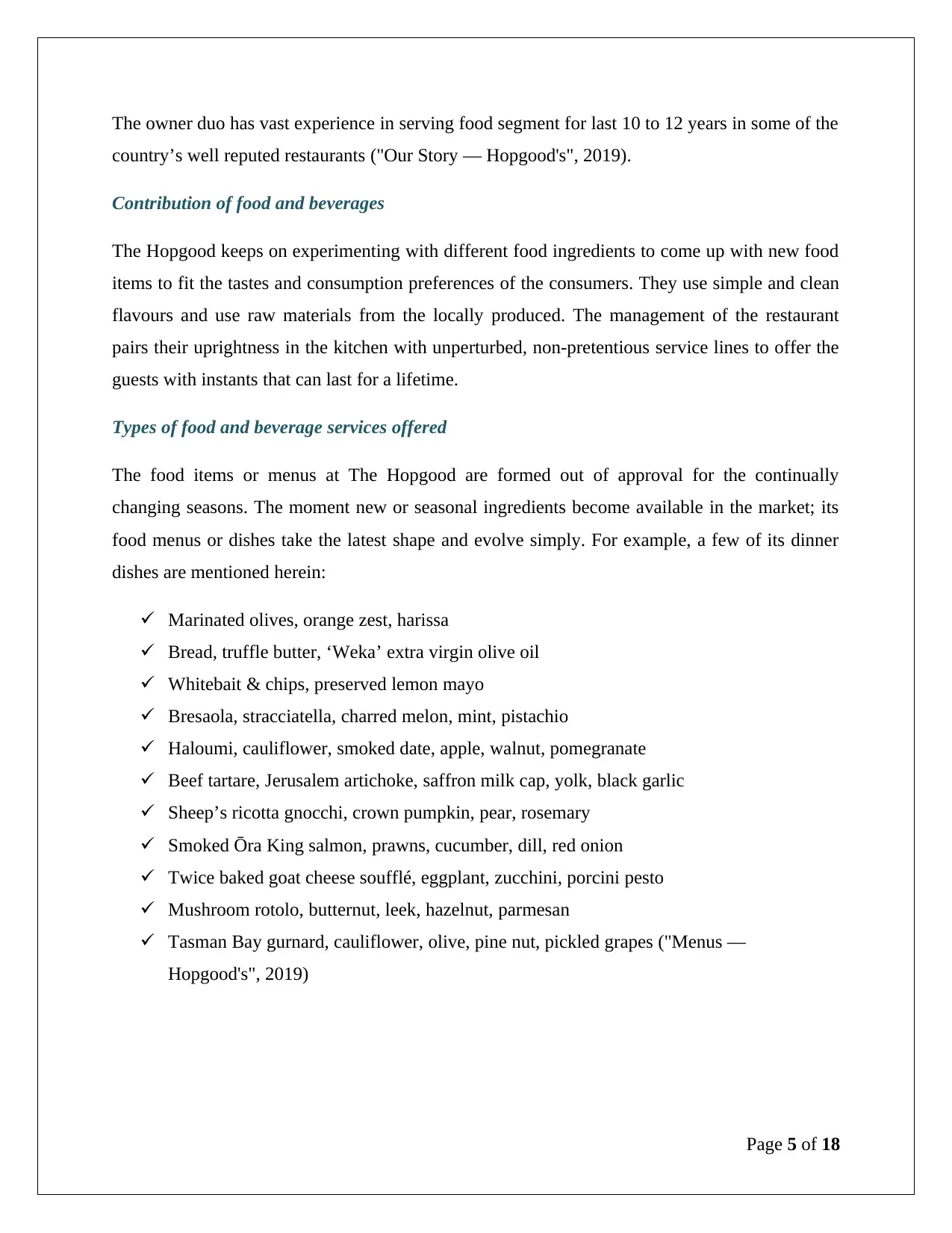
The owner duo has vast experience in serving food segment for last 10 to 12 years in some of the
country’s well reputed restaurants ("Our Story — Hopgood's", 2019).
Contribution of food and beverages
The Hopgood keeps on experimenting with different food ingredients to come up with new food
items to fit the tastes and consumption preferences of the consumers. They use simple and clean
flavours and use raw materials from the locally produced. The management of the restaurant
pairs their uprightness in the kitchen with unperturbed, non-pretentious service lines to offer the
guests with instants that can last for a lifetime.
Types of food and beverage services offered
The food items or menus at The Hopgood are formed out of approval for the continually
changing seasons. The moment new or seasonal ingredients become available in the market; its
food menus or dishes take the latest shape and evolve simply. For example, a few of its dinner
dishes are mentioned herein:
Marinated olives, orange zest, harissa
Bread, truffle butter, ‘Weka’ extra virgin olive oil
Whitebait & chips, preserved lemon mayo
Bresaola, stracciatella, charred melon, mint, pistachio
Haloumi, cauliflower, smoked date, apple, walnut, pomegranate
Beef tartare, Jerusalem artichoke, saffron milk cap, yolk, black garlic
Sheep’s ricotta gnocchi, crown pumpkin, pear, rosemary
Smoked Ōra King salmon, prawns, cucumber, dill, red onion
Twice baked goat cheese soufflé, eggplant, zucchini, porcini pesto
Mushroom rotolo, butternut, leek, hazelnut, parmesan
Tasman Bay gurnard, cauliflower, olive, pine nut, pickled grapes ("Menus —
Hopgood's", 2019)
Page 5 of 18
country’s well reputed restaurants ("Our Story — Hopgood's", 2019).
Contribution of food and beverages
The Hopgood keeps on experimenting with different food ingredients to come up with new food
items to fit the tastes and consumption preferences of the consumers. They use simple and clean
flavours and use raw materials from the locally produced. The management of the restaurant
pairs their uprightness in the kitchen with unperturbed, non-pretentious service lines to offer the
guests with instants that can last for a lifetime.
Types of food and beverage services offered
The food items or menus at The Hopgood are formed out of approval for the continually
changing seasons. The moment new or seasonal ingredients become available in the market; its
food menus or dishes take the latest shape and evolve simply. For example, a few of its dinner
dishes are mentioned herein:
Marinated olives, orange zest, harissa
Bread, truffle butter, ‘Weka’ extra virgin olive oil
Whitebait & chips, preserved lemon mayo
Bresaola, stracciatella, charred melon, mint, pistachio
Haloumi, cauliflower, smoked date, apple, walnut, pomegranate
Beef tartare, Jerusalem artichoke, saffron milk cap, yolk, black garlic
Sheep’s ricotta gnocchi, crown pumpkin, pear, rosemary
Smoked Ōra King salmon, prawns, cucumber, dill, red onion
Twice baked goat cheese soufflé, eggplant, zucchini, porcini pesto
Mushroom rotolo, butternut, leek, hazelnut, parmesan
Tasman Bay gurnard, cauliflower, olive, pine nut, pickled grapes ("Menus —
Hopgood's", 2019)
Page 5 of 18
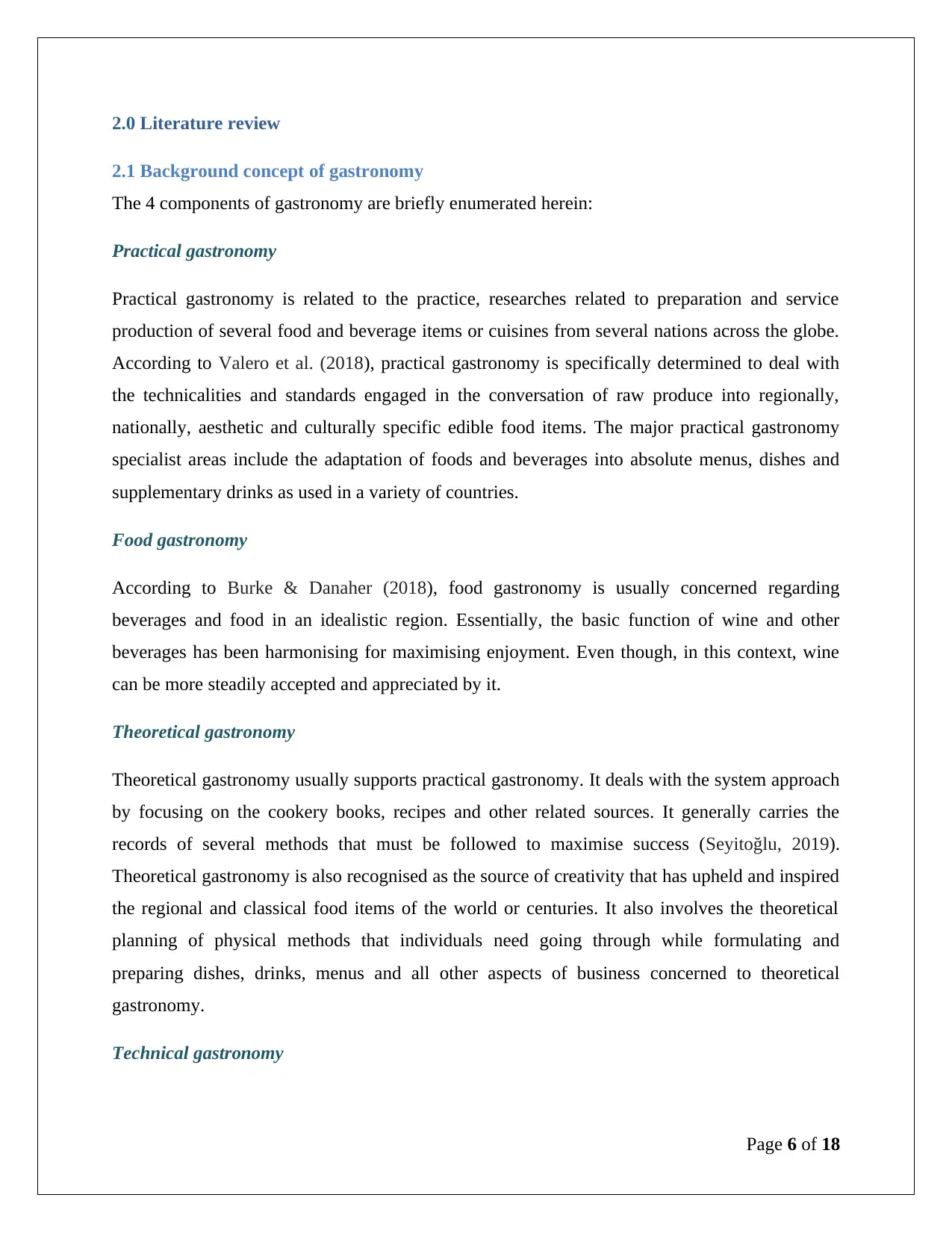
2.0 Literature review
2.1 Background concept of gastronomy
The 4 components of gastronomy are briefly enumerated herein:
Practical gastronomy
Practical gastronomy is related to the practice, researches related to preparation and service
production of several food and beverage items or cuisines from several nations across the globe.
According to Valero et al. (2018), practical gastronomy is specifically determined to deal with
the technicalities and standards engaged in the conversation of raw produce into regionally,
nationally, aesthetic and culturally specific edible food items. The major practical gastronomy
specialist areas include the adaptation of foods and beverages into absolute menus, dishes and
supplementary drinks as used in a variety of countries.
Food gastronomy
According to Burke & Danaher (2018), food gastronomy is usually concerned regarding
beverages and food in an idealistic region. Essentially, the basic function of wine and other
beverages has been harmonising for maximising enjoyment. Even though, in this context, wine
can be more steadily accepted and appreciated by it.
Theoretical gastronomy
Theoretical gastronomy usually supports practical gastronomy. It deals with the system approach
by focusing on the cookery books, recipes and other related sources. It generally carries the
records of several methods that must be followed to maximise success (Seyitoğlu, 2019).
Theoretical gastronomy is also recognised as the source of creativity that has upheld and inspired
the regional and classical food items of the world or centuries. It also involves the theoretical
planning of physical methods that individuals need going through while formulating and
preparing dishes, drinks, menus and all other aspects of business concerned to theoretical
gastronomy.
Technical gastronomy
Page 6 of 18
2.1 Background concept of gastronomy
The 4 components of gastronomy are briefly enumerated herein:
Practical gastronomy
Practical gastronomy is related to the practice, researches related to preparation and service
production of several food and beverage items or cuisines from several nations across the globe.
According to Valero et al. (2018), practical gastronomy is specifically determined to deal with
the technicalities and standards engaged in the conversation of raw produce into regionally,
nationally, aesthetic and culturally specific edible food items. The major practical gastronomy
specialist areas include the adaptation of foods and beverages into absolute menus, dishes and
supplementary drinks as used in a variety of countries.
Food gastronomy
According to Burke & Danaher (2018), food gastronomy is usually concerned regarding
beverages and food in an idealistic region. Essentially, the basic function of wine and other
beverages has been harmonising for maximising enjoyment. Even though, in this context, wine
can be more steadily accepted and appreciated by it.
Theoretical gastronomy
Theoretical gastronomy usually supports practical gastronomy. It deals with the system approach
by focusing on the cookery books, recipes and other related sources. It generally carries the
records of several methods that must be followed to maximise success (Seyitoğlu, 2019).
Theoretical gastronomy is also recognised as the source of creativity that has upheld and inspired
the regional and classical food items of the world or centuries. It also involves the theoretical
planning of physical methods that individuals need going through while formulating and
preparing dishes, drinks, menus and all other aspects of business concerned to theoretical
gastronomy.
Technical gastronomy
Page 6 of 18
⊘ This is a preview!⊘
Do you want full access?
Subscribe today to unlock all pages.

Trusted by 1+ million students worldwide
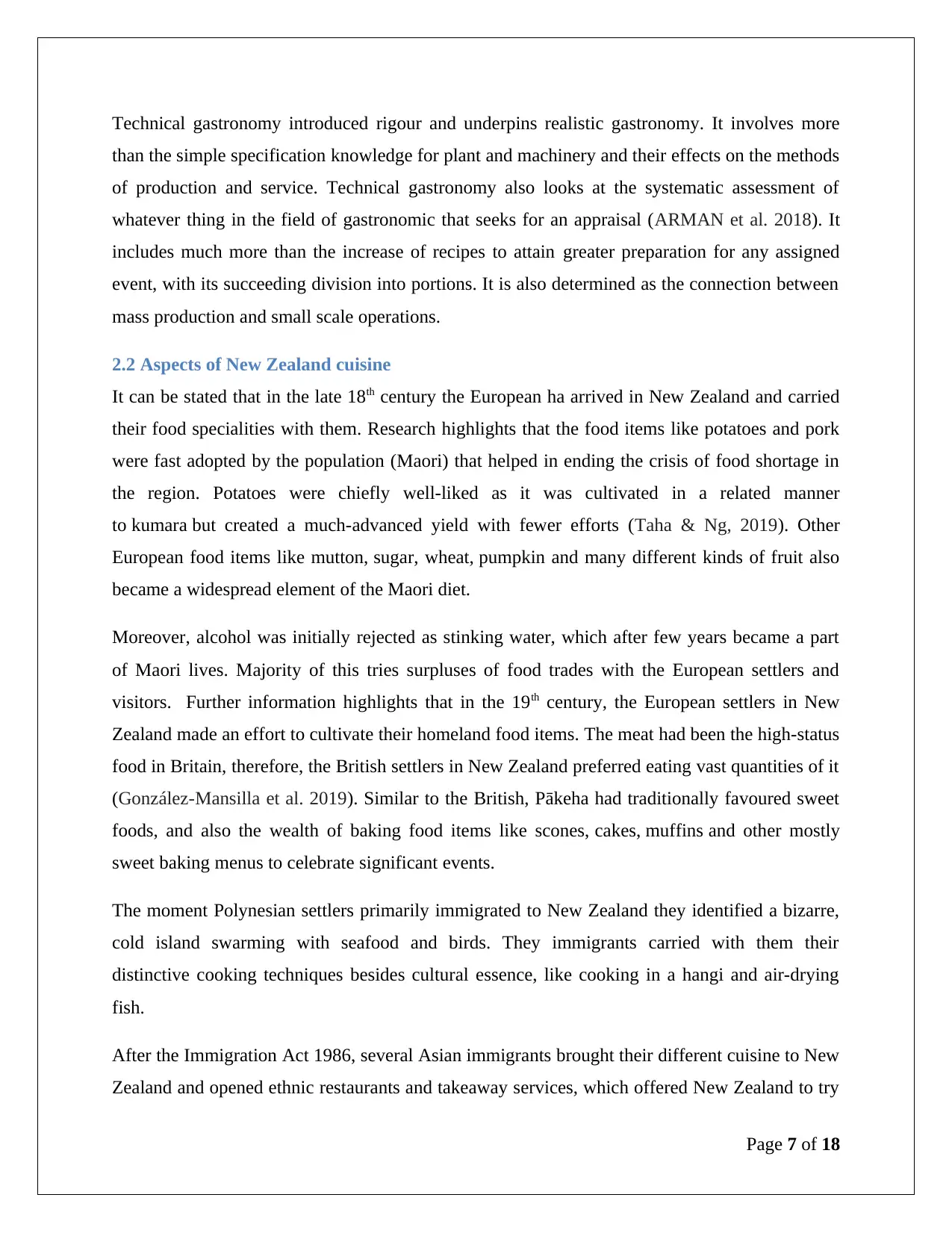
Technical gastronomy introduced rigour and underpins realistic gastronomy. It involves more
than the simple specification knowledge for plant and machinery and their effects on the methods
of production and service. Technical gastronomy also looks at the systematic assessment of
whatever thing in the field of gastronomic that seeks for an appraisal (ARMAN et al. 2018). It
includes much more than the increase of recipes to attain greater preparation for any assigned
event, with its succeeding division into portions. It is also determined as the connection between
mass production and small scale operations.
2.2 Aspects of New Zealand cuisine
It can be stated that in the late 18th century the European ha arrived in New Zealand and carried
their food specialities with them. Research highlights that the food items like potatoes and pork
were fast adopted by the population (Maori) that helped in ending the crisis of food shortage in
the region. Potatoes were chiefly well-liked as it was cultivated in a related manner
to kumara but created a much-advanced yield with fewer efforts (Taha & Ng, 2019). Other
European food items like mutton, sugar, wheat, pumpkin and many different kinds of fruit also
became a widespread element of the Maori diet.
Moreover, alcohol was initially rejected as stinking water, which after few years became a part
of Maori lives. Majority of this tries surpluses of food trades with the European settlers and
visitors. Further information highlights that in the 19th century, the European settlers in New
Zealand made an effort to cultivate their homeland food items. The meat had been the high-status
food in Britain, therefore, the British settlers in New Zealand preferred eating vast quantities of it
(González-Mansilla et al. 2019). Similar to the British, Pākeha had traditionally favoured sweet
foods, and also the wealth of baking food items like scones, cakes, muffins and other mostly
sweet baking menus to celebrate significant events.
The moment Polynesian settlers primarily immigrated to New Zealand they identified a bizarre,
cold island swarming with seafood and birds. They immigrants carried with them their
distinctive cooking techniques besides cultural essence, like cooking in a hangi and air-drying
fish.
After the Immigration Act 1986, several Asian immigrants brought their different cuisine to New
Zealand and opened ethnic restaurants and takeaway services, which offered New Zealand to try
Page 7 of 18
than the simple specification knowledge for plant and machinery and their effects on the methods
of production and service. Technical gastronomy also looks at the systematic assessment of
whatever thing in the field of gastronomic that seeks for an appraisal (ARMAN et al. 2018). It
includes much more than the increase of recipes to attain greater preparation for any assigned
event, with its succeeding division into portions. It is also determined as the connection between
mass production and small scale operations.
2.2 Aspects of New Zealand cuisine
It can be stated that in the late 18th century the European ha arrived in New Zealand and carried
their food specialities with them. Research highlights that the food items like potatoes and pork
were fast adopted by the population (Maori) that helped in ending the crisis of food shortage in
the region. Potatoes were chiefly well-liked as it was cultivated in a related manner
to kumara but created a much-advanced yield with fewer efforts (Taha & Ng, 2019). Other
European food items like mutton, sugar, wheat, pumpkin and many different kinds of fruit also
became a widespread element of the Maori diet.
Moreover, alcohol was initially rejected as stinking water, which after few years became a part
of Maori lives. Majority of this tries surpluses of food trades with the European settlers and
visitors. Further information highlights that in the 19th century, the European settlers in New
Zealand made an effort to cultivate their homeland food items. The meat had been the high-status
food in Britain, therefore, the British settlers in New Zealand preferred eating vast quantities of it
(González-Mansilla et al. 2019). Similar to the British, Pākeha had traditionally favoured sweet
foods, and also the wealth of baking food items like scones, cakes, muffins and other mostly
sweet baking menus to celebrate significant events.
The moment Polynesian settlers primarily immigrated to New Zealand they identified a bizarre,
cold island swarming with seafood and birds. They immigrants carried with them their
distinctive cooking techniques besides cultural essence, like cooking in a hangi and air-drying
fish.
After the Immigration Act 1986, several Asian immigrants brought their different cuisine to New
Zealand and opened ethnic restaurants and takeaway services, which offered New Zealand to try
Page 7 of 18
Paraphrase This Document
Need a fresh take? Get an instant paraphrase of this document with our AI Paraphraser
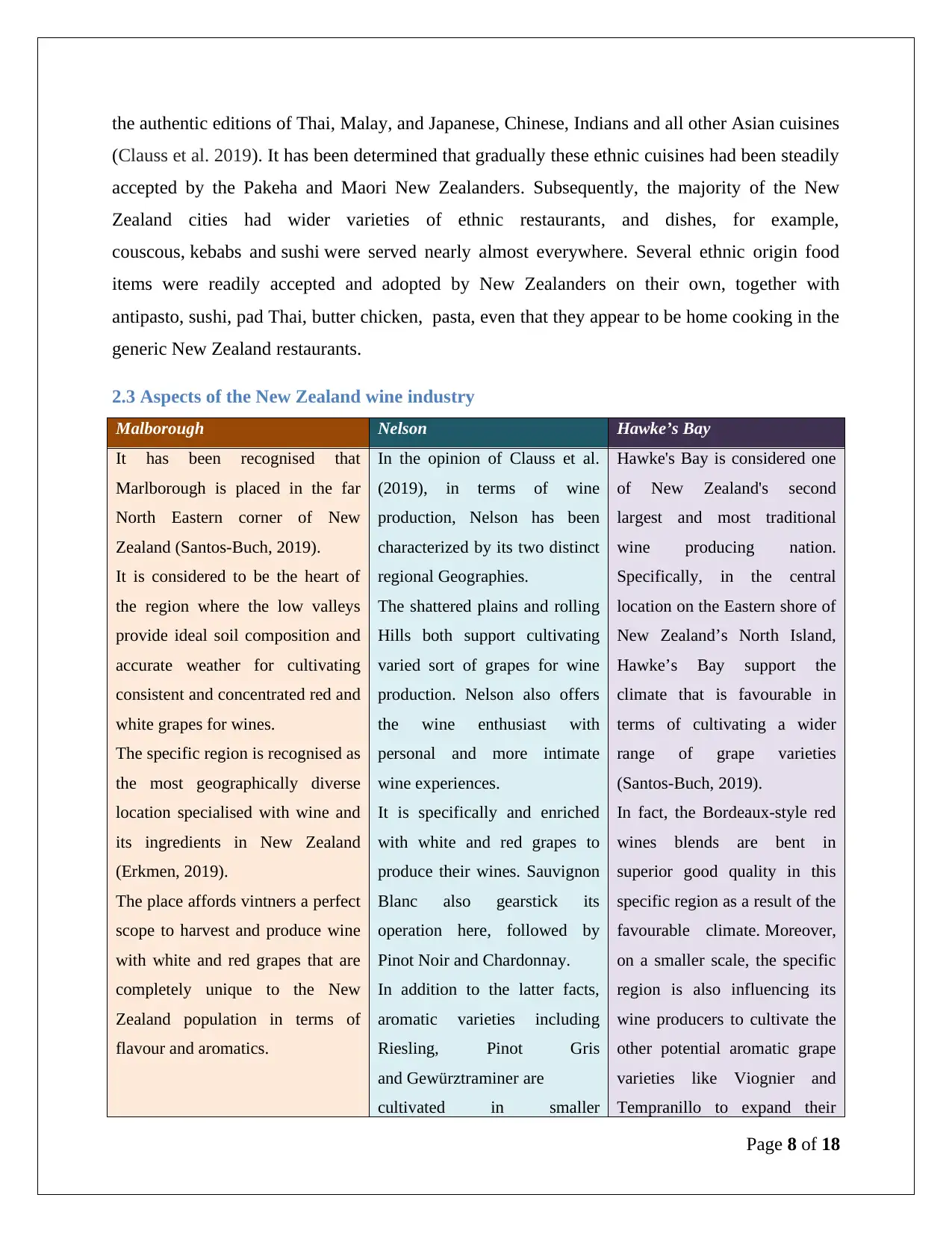
the authentic editions of Thai, Malay, and Japanese, Chinese, Indians and all other Asian cuisines
(Clauss et al. 2019). It has been determined that gradually these ethnic cuisines had been steadily
accepted by the Pakeha and Maori New Zealanders. Subsequently, the majority of the New
Zealand cities had wider varieties of ethnic restaurants, and dishes, for example,
couscous, kebabs and sushi were served nearly almost everywhere. Several ethnic origin food
items were readily accepted and adopted by New Zealanders on their own, together with
antipasto, sushi, pad Thai, butter chicken, pasta, even that they appear to be home cooking in the
generic New Zealand restaurants.
2.3 Aspects of the New Zealand wine industry
Malborough Nelson Hawke’s Bay
It has been recognised that
Marlborough is placed in the far
North Eastern corner of New
Zealand (Santos-Buch, 2019).
It is considered to be the heart of
the region where the low valleys
provide ideal soil composition and
accurate weather for cultivating
consistent and concentrated red and
white grapes for wines.
The specific region is recognised as
the most geographically diverse
location specialised with wine and
its ingredients in New Zealand
(Erkmen, 2019).
The place affords vintners a perfect
scope to harvest and produce wine
with white and red grapes that are
completely unique to the New
Zealand population in terms of
flavour and aromatics.
In the opinion of Clauss et al.
(2019), in terms of wine
production, Nelson has been
characterized by its two distinct
regional Geographies.
The shattered plains and rolling
Hills both support cultivating
varied sort of grapes for wine
production. Nelson also offers
the wine enthusiast with
personal and more intimate
wine experiences.
It is specifically and enriched
with white and red grapes to
produce their wines. Sauvignon
Blanc also gearstick its
operation here, followed by
Pinot Noir and Chardonnay.
In addition to the latter facts,
aromatic varieties including
Riesling, Pinot Gris
and Gewürztraminer are
cultivated in smaller
Hawke's Bay is considered one
of New Zealand's second
largest and most traditional
wine producing nation.
Specifically, in the central
location on the Eastern shore of
New Zealand’s North Island,
Hawke’s Bay support the
climate that is favourable in
terms of cultivating a wider
range of grape varieties
(Santos-Buch, 2019).
In fact, the Bordeaux-style red
wines blends are bent in
superior good quality in this
specific region as a result of the
favourable climate. Moreover,
on a smaller scale, the specific
region is also influencing its
wine producers to cultivate the
other potential aromatic grape
varieties like Viognier and
Tempranillo to expand their
Page 8 of 18
(Clauss et al. 2019). It has been determined that gradually these ethnic cuisines had been steadily
accepted by the Pakeha and Maori New Zealanders. Subsequently, the majority of the New
Zealand cities had wider varieties of ethnic restaurants, and dishes, for example,
couscous, kebabs and sushi were served nearly almost everywhere. Several ethnic origin food
items were readily accepted and adopted by New Zealanders on their own, together with
antipasto, sushi, pad Thai, butter chicken, pasta, even that they appear to be home cooking in the
generic New Zealand restaurants.
2.3 Aspects of the New Zealand wine industry
Malborough Nelson Hawke’s Bay
It has been recognised that
Marlborough is placed in the far
North Eastern corner of New
Zealand (Santos-Buch, 2019).
It is considered to be the heart of
the region where the low valleys
provide ideal soil composition and
accurate weather for cultivating
consistent and concentrated red and
white grapes for wines.
The specific region is recognised as
the most geographically diverse
location specialised with wine and
its ingredients in New Zealand
(Erkmen, 2019).
The place affords vintners a perfect
scope to harvest and produce wine
with white and red grapes that are
completely unique to the New
Zealand population in terms of
flavour and aromatics.
In the opinion of Clauss et al.
(2019), in terms of wine
production, Nelson has been
characterized by its two distinct
regional Geographies.
The shattered plains and rolling
Hills both support cultivating
varied sort of grapes for wine
production. Nelson also offers
the wine enthusiast with
personal and more intimate
wine experiences.
It is specifically and enriched
with white and red grapes to
produce their wines. Sauvignon
Blanc also gearstick its
operation here, followed by
Pinot Noir and Chardonnay.
In addition to the latter facts,
aromatic varieties including
Riesling, Pinot Gris
and Gewürztraminer are
cultivated in smaller
Hawke's Bay is considered one
of New Zealand's second
largest and most traditional
wine producing nation.
Specifically, in the central
location on the Eastern shore of
New Zealand’s North Island,
Hawke’s Bay support the
climate that is favourable in
terms of cultivating a wider
range of grape varieties
(Santos-Buch, 2019).
In fact, the Bordeaux-style red
wines blends are bent in
superior good quality in this
specific region as a result of the
favourable climate. Moreover,
on a smaller scale, the specific
region is also influencing its
wine producers to cultivate the
other potential aromatic grape
varieties like Viognier and
Tempranillo to expand their
Page 8 of 18
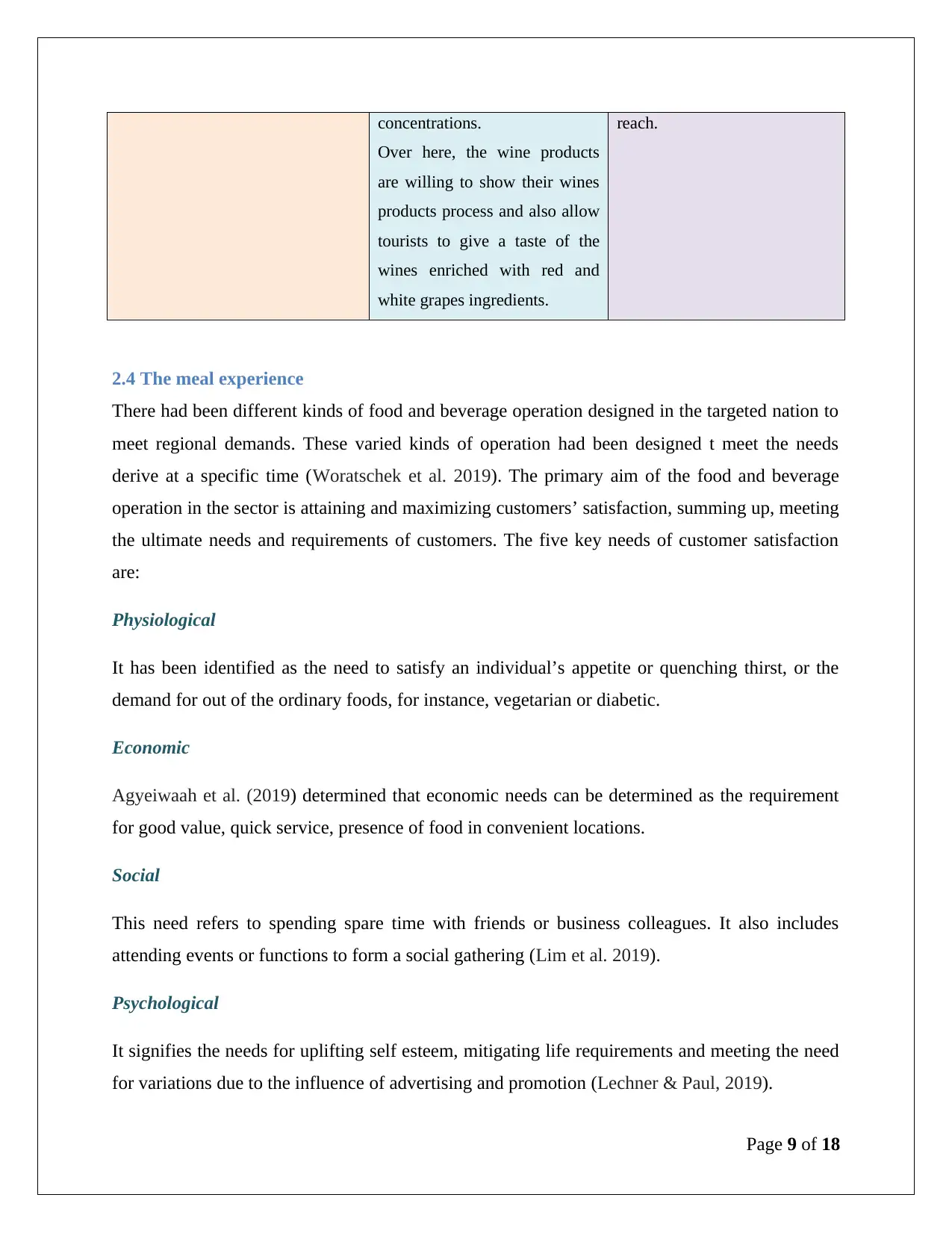
concentrations.
Over here, the wine products
are willing to show their wines
products process and also allow
tourists to give a taste of the
wines enriched with red and
white grapes ingredients.
reach.
2.4 The meal experience
There had been different kinds of food and beverage operation designed in the targeted nation to
meet regional demands. These varied kinds of operation had been designed t meet the needs
derive at a specific time (Woratschek et al. 2019). The primary aim of the food and beverage
operation in the sector is attaining and maximizing customers’ satisfaction, summing up, meeting
the ultimate needs and requirements of customers. The five key needs of customer satisfaction
are:
Physiological
It has been identified as the need to satisfy an individual’s appetite or quenching thirst, or the
demand for out of the ordinary foods, for instance, vegetarian or diabetic.
Economic
Agyeiwaah et al. (2019) determined that economic needs can be determined as the requirement
for good value, quick service, presence of food in convenient locations.
Social
This need refers to spending spare time with friends or business colleagues. It also includes
attending events or functions to form a social gathering (Lim et al. 2019).
Psychological
It signifies the needs for uplifting self esteem, mitigating life requirements and meeting the need
for variations due to the influence of advertising and promotion (Lechner & Paul, 2019).
Page 9 of 18
Over here, the wine products
are willing to show their wines
products process and also allow
tourists to give a taste of the
wines enriched with red and
white grapes ingredients.
reach.
2.4 The meal experience
There had been different kinds of food and beverage operation designed in the targeted nation to
meet regional demands. These varied kinds of operation had been designed t meet the needs
derive at a specific time (Woratschek et al. 2019). The primary aim of the food and beverage
operation in the sector is attaining and maximizing customers’ satisfaction, summing up, meeting
the ultimate needs and requirements of customers. The five key needs of customer satisfaction
are:
Physiological
It has been identified as the need to satisfy an individual’s appetite or quenching thirst, or the
demand for out of the ordinary foods, for instance, vegetarian or diabetic.
Economic
Agyeiwaah et al. (2019) determined that economic needs can be determined as the requirement
for good value, quick service, presence of food in convenient locations.
Social
This need refers to spending spare time with friends or business colleagues. It also includes
attending events or functions to form a social gathering (Lim et al. 2019).
Psychological
It signifies the needs for uplifting self esteem, mitigating life requirements and meeting the need
for variations due to the influence of advertising and promotion (Lechner & Paul, 2019).
Page 9 of 18
⊘ This is a preview!⊘
Do you want full access?
Subscribe today to unlock all pages.

Trusted by 1+ million students worldwide
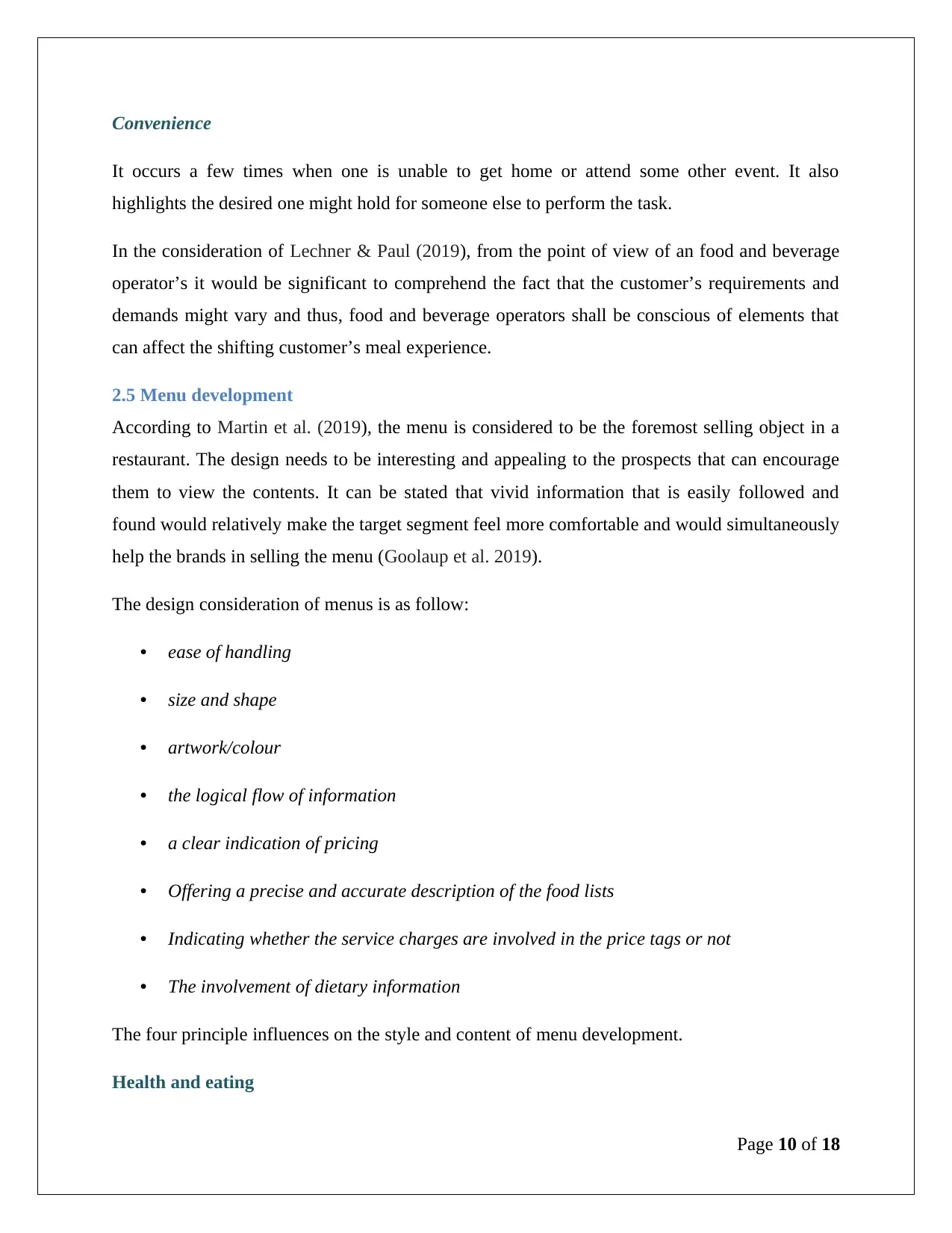
Convenience
It occurs a few times when one is unable to get home or attend some other event. It also
highlights the desired one might hold for someone else to perform the task.
In the consideration of Lechner & Paul (2019), from the point of view of an food and beverage
operator’s it would be significant to comprehend the fact that the customer’s requirements and
demands might vary and thus, food and beverage operators shall be conscious of elements that
can affect the shifting customer’s meal experience.
2.5 Menu development
According to Martin et al. (2019), the menu is considered to be the foremost selling object in a
restaurant. The design needs to be interesting and appealing to the prospects that can encourage
them to view the contents. It can be stated that vivid information that is easily followed and
found would relatively make the target segment feel more comfortable and would simultaneously
help the brands in selling the menu (Goolaup et al. 2019).
The design consideration of menus is as follow:
• ease of handling
• size and shape
• artwork/colour
• the logical flow of information
• a clear indication of pricing
• Offering a precise and accurate description of the food lists
• Indicating whether the service charges are involved in the price tags or not
• The involvement of dietary information
The four principle influences on the style and content of menu development.
Health and eating
Page 10 of 18
It occurs a few times when one is unable to get home or attend some other event. It also
highlights the desired one might hold for someone else to perform the task.
In the consideration of Lechner & Paul (2019), from the point of view of an food and beverage
operator’s it would be significant to comprehend the fact that the customer’s requirements and
demands might vary and thus, food and beverage operators shall be conscious of elements that
can affect the shifting customer’s meal experience.
2.5 Menu development
According to Martin et al. (2019), the menu is considered to be the foremost selling object in a
restaurant. The design needs to be interesting and appealing to the prospects that can encourage
them to view the contents. It can be stated that vivid information that is easily followed and
found would relatively make the target segment feel more comfortable and would simultaneously
help the brands in selling the menu (Goolaup et al. 2019).
The design consideration of menus is as follow:
• ease of handling
• size and shape
• artwork/colour
• the logical flow of information
• a clear indication of pricing
• Offering a precise and accurate description of the food lists
• Indicating whether the service charges are involved in the price tags or not
• The involvement of dietary information
The four principle influences on the style and content of menu development.
Health and eating
Page 10 of 18
Paraphrase This Document
Need a fresh take? Get an instant paraphrase of this document with our AI Paraphraser
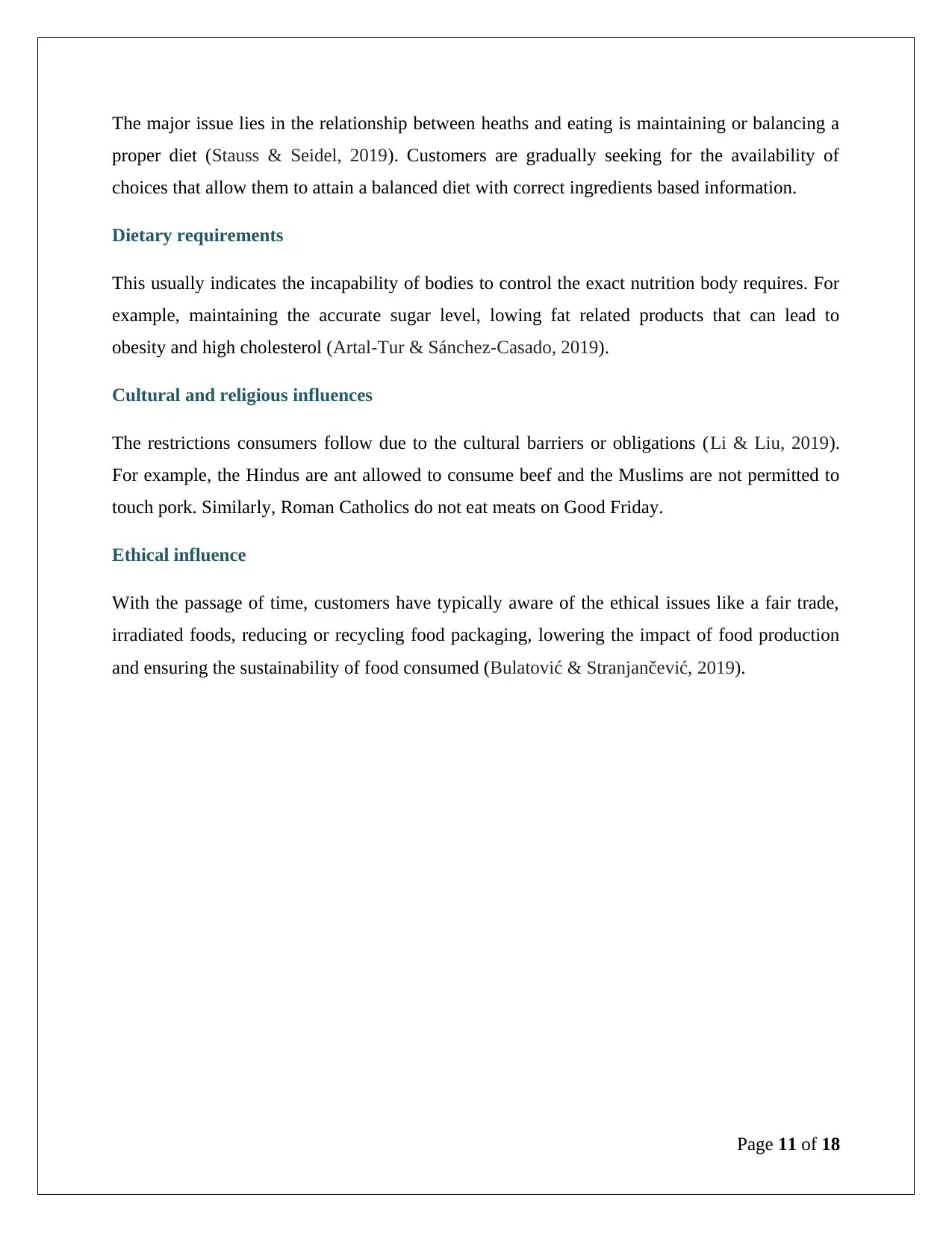
The major issue lies in the relationship between heaths and eating is maintaining or balancing a
proper diet (Stauss & Seidel, 2019). Customers are gradually seeking for the availability of
choices that allow them to attain a balanced diet with correct ingredients based information.
Dietary requirements
This usually indicates the incapability of bodies to control the exact nutrition body requires. For
example, maintaining the accurate sugar level, lowing fat related products that can lead to
obesity and high cholesterol (Artal-Tur & Sánchez-Casado, 2019).
Cultural and religious influences
The restrictions consumers follow due to the cultural barriers or obligations (Li & Liu, 2019).
For example, the Hindus are ant allowed to consume beef and the Muslims are not permitted to
touch pork. Similarly, Roman Catholics do not eat meats on Good Friday.
Ethical influence
With the passage of time, customers have typically aware of the ethical issues like a fair trade,
irradiated foods, reducing or recycling food packaging, lowering the impact of food production
and ensuring the sustainability of food consumed (Bulatović & Stranjančević, 2019).
Page 11 of 18
proper diet (Stauss & Seidel, 2019). Customers are gradually seeking for the availability of
choices that allow them to attain a balanced diet with correct ingredients based information.
Dietary requirements
This usually indicates the incapability of bodies to control the exact nutrition body requires. For
example, maintaining the accurate sugar level, lowing fat related products that can lead to
obesity and high cholesterol (Artal-Tur & Sánchez-Casado, 2019).
Cultural and religious influences
The restrictions consumers follow due to the cultural barriers or obligations (Li & Liu, 2019).
For example, the Hindus are ant allowed to consume beef and the Muslims are not permitted to
touch pork. Similarly, Roman Catholics do not eat meats on Good Friday.
Ethical influence
With the passage of time, customers have typically aware of the ethical issues like a fair trade,
irradiated foods, reducing or recycling food packaging, lowering the impact of food production
and ensuring the sustainability of food consumed (Bulatović & Stranjančević, 2019).
Page 11 of 18
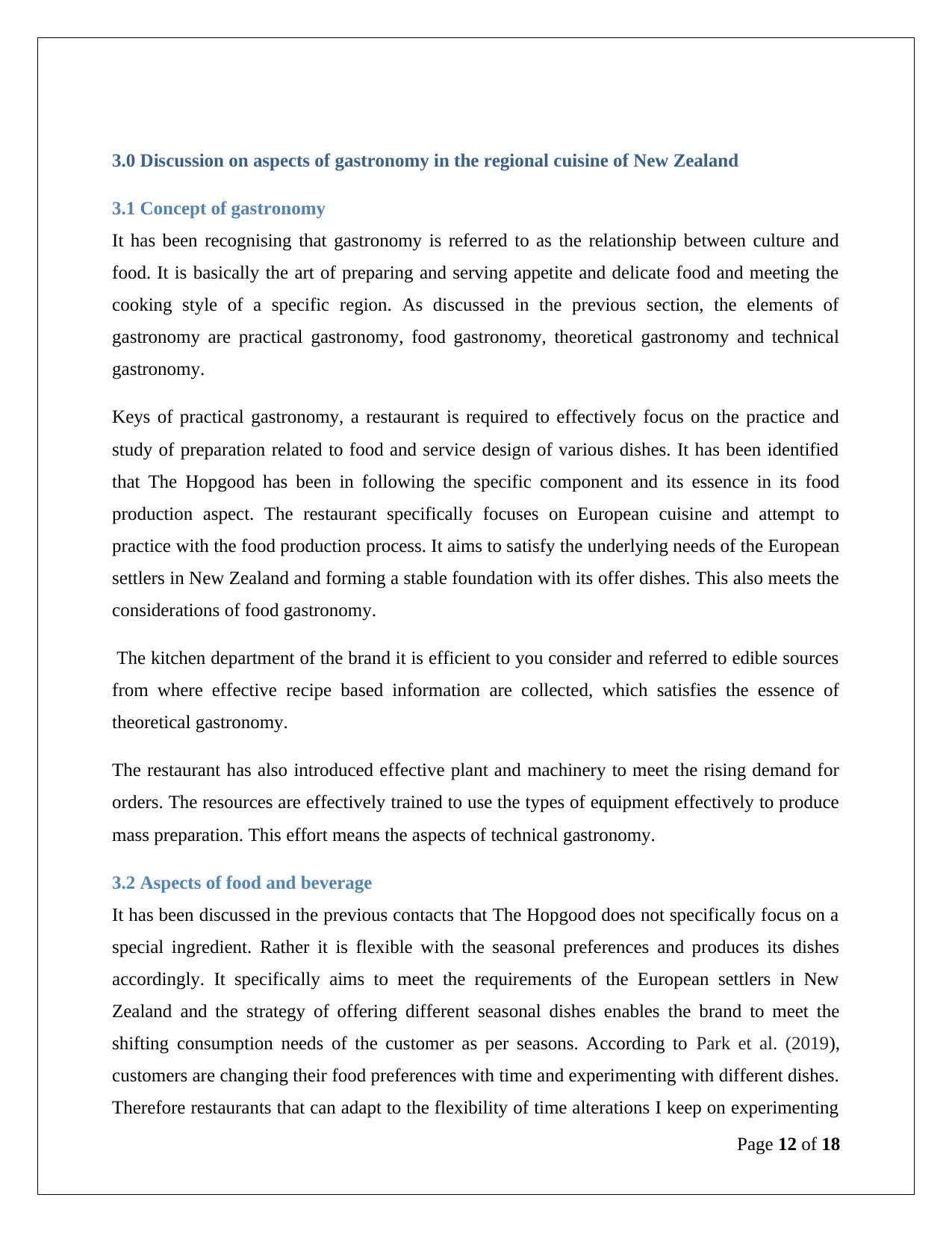
3.0 Discussion on aspects of gastronomy in the regional cuisine of New Zealand
3.1 Concept of gastronomy
It has been recognising that gastronomy is referred to as the relationship between culture and
food. It is basically the art of preparing and serving appetite and delicate food and meeting the
cooking style of a specific region. As discussed in the previous section, the elements of
gastronomy are practical gastronomy, food gastronomy, theoretical gastronomy and technical
gastronomy.
Keys of practical gastronomy, a restaurant is required to effectively focus on the practice and
study of preparation related to food and service design of various dishes. It has been identified
that The Hopgood has been in following the specific component and its essence in its food
production aspect. The restaurant specifically focuses on European cuisine and attempt to
practice with the food production process. It aims to satisfy the underlying needs of the European
settlers in New Zealand and forming a stable foundation with its offer dishes. This also meets the
considerations of food gastronomy.
The kitchen department of the brand it is efficient to you consider and referred to edible sources
from where effective recipe based information are collected, which satisfies the essence of
theoretical gastronomy.
The restaurant has also introduced effective plant and machinery to meet the rising demand for
orders. The resources are effectively trained to use the types of equipment effectively to produce
mass preparation. This effort means the aspects of technical gastronomy.
3.2 Aspects of food and beverage
It has been discussed in the previous contacts that The Hopgood does not specifically focus on a
special ingredient. Rather it is flexible with the seasonal preferences and produces its dishes
accordingly. It specifically aims to meet the requirements of the European settlers in New
Zealand and the strategy of offering different seasonal dishes enables the brand to meet the
shifting consumption needs of the customer as per seasons. According to Park et al. (2019),
customers are changing their food preferences with time and experimenting with different dishes.
Therefore restaurants that can adapt to the flexibility of time alterations I keep on experimenting
Page 12 of 18
3.1 Concept of gastronomy
It has been recognising that gastronomy is referred to as the relationship between culture and
food. It is basically the art of preparing and serving appetite and delicate food and meeting the
cooking style of a specific region. As discussed in the previous section, the elements of
gastronomy are practical gastronomy, food gastronomy, theoretical gastronomy and technical
gastronomy.
Keys of practical gastronomy, a restaurant is required to effectively focus on the practice and
study of preparation related to food and service design of various dishes. It has been identified
that The Hopgood has been in following the specific component and its essence in its food
production aspect. The restaurant specifically focuses on European cuisine and attempt to
practice with the food production process. It aims to satisfy the underlying needs of the European
settlers in New Zealand and forming a stable foundation with its offer dishes. This also meets the
considerations of food gastronomy.
The kitchen department of the brand it is efficient to you consider and referred to edible sources
from where effective recipe based information are collected, which satisfies the essence of
theoretical gastronomy.
The restaurant has also introduced effective plant and machinery to meet the rising demand for
orders. The resources are effectively trained to use the types of equipment effectively to produce
mass preparation. This effort means the aspects of technical gastronomy.
3.2 Aspects of food and beverage
It has been discussed in the previous contacts that The Hopgood does not specifically focus on a
special ingredient. Rather it is flexible with the seasonal preferences and produces its dishes
accordingly. It specifically aims to meet the requirements of the European settlers in New
Zealand and the strategy of offering different seasonal dishes enables the brand to meet the
shifting consumption needs of the customer as per seasons. According to Park et al. (2019),
customers are changing their food preferences with time and experimenting with different dishes.
Therefore restaurants that can adapt to the flexibility of time alterations I keep on experimenting
Page 12 of 18
⊘ This is a preview!⊘
Do you want full access?
Subscribe today to unlock all pages.

Trusted by 1+ million students worldwide
1 out of 18
Related Documents
Your All-in-One AI-Powered Toolkit for Academic Success.
+13062052269
info@desklib.com
Available 24*7 on WhatsApp / Email
![[object Object]](/_next/static/media/star-bottom.7253800d.svg)
Unlock your academic potential
Copyright © 2020–2025 A2Z Services. All Rights Reserved. Developed and managed by ZUCOL.





